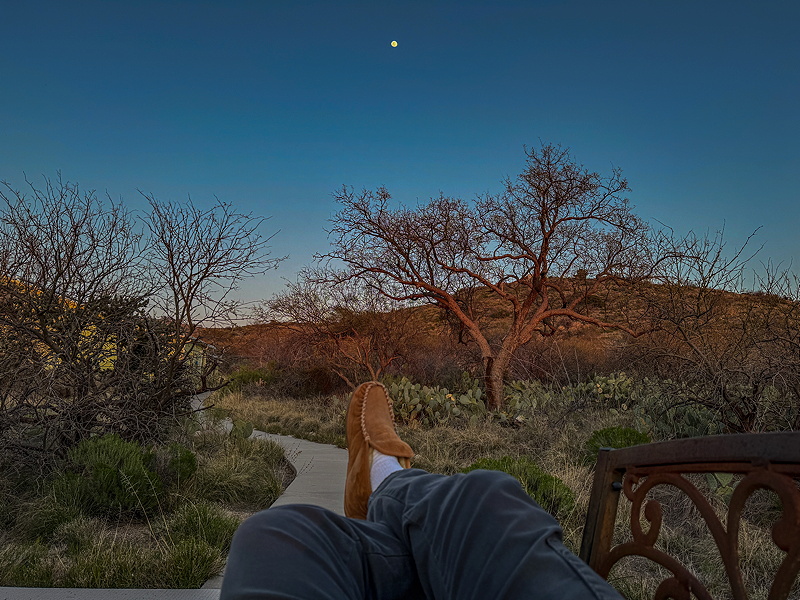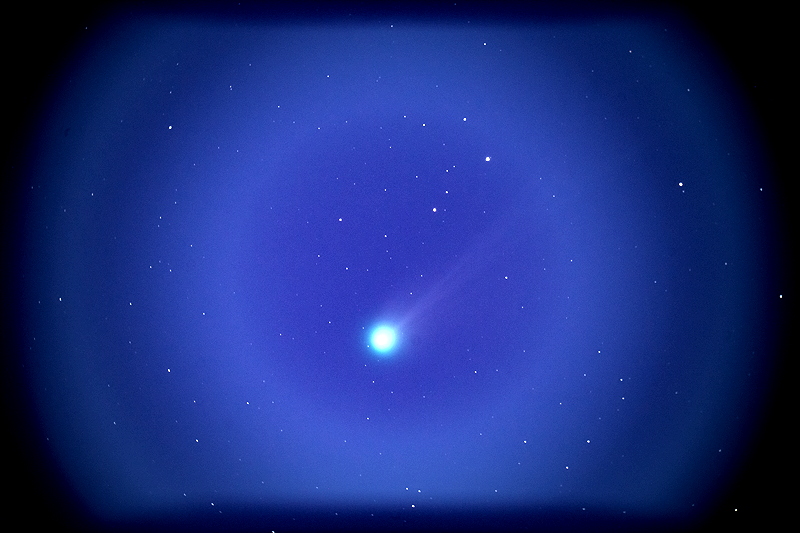Dark Sky activities, Total Solar Eclipse dry run,
Moon, Comet Pons-Brooks
Posted: 22 March 2024
Wednesday, 20 March 2024, the Pinal County Board of Supervisors (link to the video) issued a Proclamation for International Dark Sky Week. That evening I attended a meeting of the Southern Arizona Chapter of DarkSky International.
The sky dawned clear on Thursday, 21 March. Although the Partial Solar Eclipse on 14 October 2023 provided an excellent opportunity for dry running my equipment and procedures, I wanted to do another dry run closer to the date of the Total Solar Eclipse. Although there were some clouds in the sky by mid-day, with the forecasts showing cloudy days upcoming I decided to get a dry run in while I could. I first checked out my Lunt SUNoculars. The Sun appeared nice with three small sunspots visible.
I then set up my iOptron SkyTracker Pro and Manfrotto Geared Head. I set the Latitude for my eclipse location and did some tests with the Sun high in the sky (as it would be during the eclipse). I mounted my Nikon D850 DSLR with a Nikon 70-300mm lens on the Geared Head. Although I do not plan to use this lens for the Solar Eclipse, I wanted to do some exposure tests in case I needed to use the lens as a backup. I then swapped to my preferred lens for the eclipse, a Tamron 150-600mm. Vibration Reduction was OFF on both lenses. I used a Thousand Oaks Solar II Type 2 Plus solar filter (originally purchased for use with my Meade ETX-90 telescope) with the 70-300mm lens and an Explore Scientific Sun Catcher Solar Filter on the 150-600mm lens. A Kendrick Self Adhesive Sun Finder was attached to each solar filter housing. I used a Nikon DG-2 Eyepiece 2X Magnifier on the camera viewfinder. The magnifier made it easy to focus on the sunspots. I wore my Lunt Solar Hat and turning it around let me use the large back flap to hide the Sun while looking through the viewfinder and at the display screen on the camera. Here are the full-frame test results with my planned exposure settings for the partial phases.
f/8, 1/1600sec, White Balance 5560K, Focal 300mm

f/8, 1/1600sec, White Balance 5560K, Focal 600mm

For photography during Totality I will be using (I hope) exposure settings similar to what I used for the 21 August 2017 Total Solar Eclipse.
Thursday evening, Pinal County in Arizona released this video about International Dark Sky Week 2024. The video was done during the Oracle State Park International Dark Sky Park Celebration on 9 March 2024.
|
Open: Thursday, 21 March 2024, 1811 MST Temperature: 77°F |
Session: 1950 Conditions: Clear |
Equipment:
12" f/8 LX600 w/StarLock
2" 24mm UWA eyepiece
Focal reducer
12x50 binoculars
Camera:
iPhone 15 Pro Max
D850 DSLR
Dome Cover OFF.
1820 MST: LX600 ON, StarLock OFF, High Precision OFF.
Viewed the gibbous Moon, 102X.
Prepared the D850 DSLR for imaging and mounted it at prime focus + focal reducer. I took some images of the Moon in case I was not able to get any images later after the sky was darker.
1835 MST: I began relaxing on the observatory patio bench.
1836 MST: Took this iPhone 15 Pro Max photo showing the Moon high in the eastern sky.

1839 MST: Sunset.
Handheld iPhone photo of the Moon taken with the Camera app (5X telephoto lens).

1900 MST: Returned to inside the observatory.
Took this D850 DSLR image of the Moon at prime focus + focal reducer (1/400sec, ISO 100). It was highly saturated in post-processing to show the minerals on the Moon's surface.

I removed the camera and viewed the Moon, 102X.
1907 MST: Wi-Fi ON.
Used SkySafari 7 Pro on the iPhone to GOTO Comet 12P/Pons-Brooks.
1910 MST: The comet was visible, 102X. In the bright twilight sky there was a nice view of the nucleus and the coma. No tail was visible.
1912 MST: I relaxed on the bench again to wait for the sky to get a little darker.
1920 MST: Back in the observatory. Viewed the comet, 102X. I then mounted the D850 DSLR at prime focus + focal reducer. I focused on a star that was visible on the D850 Live View screen.
1929 MST: StarLock ON.
This is Comet 12P/Pons-Brooks, StarLock autoguided, 30 seconds, ISO 1600, full-frame image. Some tail structure is visible in the image. The bright moonlit sky is evident.

1935 MST: Wi-Fi OFF, StarLock OFF.
Viewed the comet, 102X. Still no tail visible in the bright moonlit sky.
I then viewed Comet 12P/Pons-Brooks, 12x50 binoculars. The coma was visible, but no tail was seen in the bright moonlit sky.
Lastly, I viewed Jupiter, 102X. The four Galilean Moons were visible.
1954 MST: LX600 OFF.
With clouds and periods of rain in the forecasts for the next few days and nights, I put the Dome Cover ON.
|
Close: Thursday, 21 2024, 2008 MST Temperature: 57°F |
Session Length: 1h 57m Conditions: Clear |
Comments are welcome using Email. Please read the Email Etiquette guidance.
Cassiopeia Observatory Home Page
Copyright ©2024 Michael L. Weasner / mweasner@mac.com.
URL = http://www.weasner.com/co/Reports/2024/03/22/index.html
